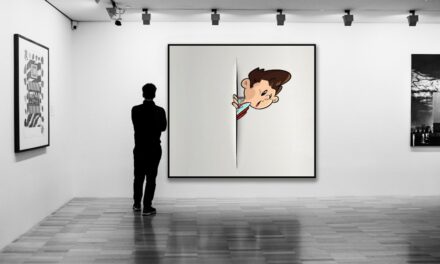Pieter de Hooch was born in 1629 in Rotterdam, a bustling port city in the Netherlands that was a hub of trade and cultural exchange during the Dutch Golden Age. The son of a bricklayer, de Hooch’s early life was marked by the modest means typical of many artists of his time. Little is known about his formative years, but it is believed that he received some artistic training, likely influenced by the vibrant artistic community surrounding him.
By the age of 26, he had moved to Delft, a city renowned for its artistic output and home to several prominent painters, including the illustrious Johannes Vermeer. De Hooch’s early career was characterised by a focus on genre painting, a popular genre that depicted scenes of everyday life. His initial works often featured figures engaged in domestic activities, reflecting the intimate and personal nature of 17th-century Dutch society.
The socio-political climate of the time, marked by prosperity and a burgeoning middle class, provided fertile ground for artists like de Hooch to explore themes of domesticity and social interaction. As he honed his craft, de Hooch began to develop a distinctive style that would set him apart from his contemporaries.
Summary
- Pieter de Hooch was born in Rotterdam in 1629 and likely trained with fellow Delft artist Nicolaes Berchem.
- Influenced by Rembrandt and other Dutch Golden Age painters, de Hooch developed a style known for its use of light and domestic scenes.
- De Hooch was a prominent member of the Delft School of Painting, known for its focus on domestic interiors and everyday life.
- Some of de Hooch’s major works include “The Courtyard of a House in Delft,” “A Woman and Her Maid in a Courtyard,” and “The Bedroom.”
- De Hooch’s paintings are celebrated for their realistic and intimate depictions of domestic life, often featuring women and children engaged in everyday activities.
Artistic Influences and Style
Pieter de Hooch’s artistic style was shaped by a confluence of influences, both from his immediate environment and the broader artistic movements of his time. The meticulous attention to detail and the emphasis on light and shadow in his works can be traced back to the influence of Caravaggio and the tenebrist painters who preceded him. However, de Hooch’s approach diverged from these influences; he sought to create a sense of harmony and balance within his compositions, often employing a more subdued palette that reflected the serene domesticity he aimed to portray.
In addition to Caravaggio’s influence, de Hooch was also inspired by the works of his contemporaries, particularly those within the Delft School of Painting. This group of artists, which included Vermeer and Carel Fabritius, shared a commitment to realism and an acute observation of light. De Hooch’s unique interpretation of these elements allowed him to create intimate scenes that resonated with viewers on an emotional level.
His ability to capture the subtleties of everyday life, combined with his innovative use of perspective and composition, established him as a significant figure in Dutch art.
The Delft School of Painting
The Delft School of Painting emerged in the mid-17th century as a distinctive movement within Dutch art, characterised by its focus on domestic interiors and intimate scenes of daily life.
De Hooch was an integral part of this movement, contributing to its development alongside other notable figures such as Vermeer and Fabritius.
The Delft School is often celebrated for its meticulous attention to detail and its ability to evoke a sense of tranquility through composition. Artists within this movement shared a common interest in exploring the nuances of domestic life, often depicting women engaged in household tasks or children at play. De Hooch’s works exemplify this focus on domesticity, as he masterfully captured the warmth and intimacy of home life.
His paintings often feature open doorways and windows that invite viewers into the scene, creating a sense of connection between the viewer and the depicted world.
Pieter de Hooch’s Major Works
Among Pieter de Hooch’s most celebrated works are “The Bedroom” (c. 1660) and “A Woman Drinking with Two Men” (c. 1663). “The Bedroom” is particularly noteworthy for its innovative use of space and light; it presents a serene interior scene where a woman is seen in a moment of quiet contemplation. The careful arrangement of furniture and the play of light filtering through the window create an atmosphere of intimacy that invites viewers to reflect on the subject’s inner life. “A Woman Drinking with Two Men” showcases de Hooch’s ability to capture social interactions within domestic settings. The painting depicts a lively gathering where figures engage in conversation over drinks, highlighting the conviviality of Dutch social life during this period. The artist’s keen eye for detail is evident in the textures of clothing and the reflections on glassware, which enhance the realism of the scene. These major works not only demonstrate de Hooch’s technical prowess but also his deep understanding of human relationships within domestic spaces.
Depiction of Domestic Life
De Hooch’s oeuvre is characterised by an unwavering focus on domestic life, which he portrayed with both warmth and authenticity. His paintings often depict women engaged in household chores or children playing, reflecting the everyday realities of 17th-century Dutch society. This emphasis on domesticity resonated with contemporary audiences who found solace in the familiar scenes that celebrated their own lives.
In many of his works, de Hooch employed open doorways and windows as compositional devices that not only framed his subjects but also symbolised the connection between private and public life. These architectural elements invite viewers into the intimate spaces he depicted while simultaneously suggesting a world beyond those walls. By capturing moments of quietude amidst bustling domesticity, de Hooch created a sense of harmony that transcended mere representation; he evoked an emotional resonance that continues to captivate audiences today.
Use of Light and Space
One of Pieter de Hooch’s most remarkable contributions to art lies in his innovative use of light and space. He possessed an extraordinary ability to manipulate natural light within his compositions, creating an ethereal quality that imbued his scenes with life. De Hooch often employed chiaroscuro techniques to enhance depth and dimension, allowing light to dance across surfaces and illuminate figures in a way that felt both realistic and poetic.
The spatial arrangements in de Hooch’s paintings are equally noteworthy; he frequently employed perspective to create a sense of depth that draws viewers into the scene. His careful consideration of architectural elements—such as doorways, windows, and furniture—allowed him to construct intricate spatial relationships that guide the viewer’s eye throughout the composition. This mastery over light and space not only defined de Hooch’s style but also set a precedent for future generations of artists who sought to explore similar themes.
Relationship with Vermeer
Pieter de Hooch’s relationship with Johannes Vermeer is one marked by mutual respect and artistic camaraderie. Both artists were active in Delft during the same period and shared similar interests in depicting domestic interiors and everyday life. While their styles differed—Vermeer often employed a more vibrant palette and focused on singular moments—there is an undeniable connection between their works that speaks to their shared environment.
Art historians have noted parallels between de Hooch’s compositions and those of Vermeer, particularly in their treatment of light and space. Both artists demonstrated an acute awareness of how light interacts with surfaces, creating atmospheric effects that enhance their narratives. It is believed that they may have influenced one another; Vermeer’s meticulous attention to detail may have inspired de Hooch’s own explorations into realism, while de Hooch’s innovative use of perspective could have informed Vermeer’s compositions.
Influence on Later Artists
Pieter de Hooch’s impact on subsequent generations of artists cannot be overstated. His innovative approach to genre painting laid the groundwork for later movements that sought to explore similar themes of domesticity and social interaction. Artists such as Jean-Baptiste-Siméon Chardin in France drew inspiration from de Hooch’s ability to capture the essence of everyday life with sensitivity and grace.
The Impressionists, for instance, admired his ability to convey atmosphere through colour and light, leading them to experiment with similar techniques in their own works. As art evolved through various movements, de Hooch’s legacy endured as artists continued to explore the complexities of human experience within domestic settings.
Recognition and Legacy
Despite his significant contributions to art during his lifetime, Pieter de Hooch did not achieve widespread recognition until centuries later. His works were often overshadowed by those of his contemporaries like Vermeer and Rembrandt, leading to periods where his contributions were overlooked or underappreciated. However, as art historians began to re-evaluate Dutch genre painting in the 19th century, de Hooch’s importance became increasingly evident.
Today, de Hooch is celebrated as one of the foremost painters of the Dutch Golden Age, with his works held in prestigious collections around the world. His ability to capture the nuances of domestic life continues to resonate with audiences, ensuring that his legacy endures through time. Exhibitions dedicated to his work have further solidified his place within art history, allowing new generations to appreciate his artistry and vision.
Controversies and Misattributions
Throughout history, Pieter de Hooch has been subject to various controversies and misattributions that have complicated our understanding of his oeuvre. Many paintings once thought to be by de Hooch have been reattributed to other artists or deemed as collaborations due to stylistic similarities with contemporaries like Vermeer or Fabritius. This has led to ongoing debates among scholars regarding authorship and authenticity.
Additionally, some critics have argued that de Hooch’s work lacks the emotional depth found in Vermeer’s paintings, leading to discussions about their relative merits within the context of Dutch art. Such controversies highlight the complexities inherent in art historical scholarship, where evolving perspectives can reshape our understanding of an artist’s significance over time.
The Continued Fascination with Pieter de Hooch
The enduring fascination with Pieter de Hooch can be attributed to several factors that continue to captivate audiences today. His ability to evoke emotion through depictions of everyday life resonates with viewers who find solace in familiar scenes that reflect their own experiences. The warmth and intimacy present in his works create a sense of nostalgia that transcends time.
Moreover, de Hooch’s innovative techniques regarding light and space remain relevant in contemporary discussions about art-making practices. Artists today continue to explore similar themes while drawing inspiration from historical figures like de Hooch who mastered these elements centuries ago. As exhibitions featuring his work emerge alongside scholarly research that delves deeper into his contributions, Pieter de Hooch remains a vital figure whose legacy continues to inspire both artists and art lovers alike.
For those interested in learning more about the techniques and materials used by artists, there is a fascinating article on protecting charcoal work with fixatives and storage. This article provides valuable insights into how to preserve and protect delicate charcoal drawings. It is a useful resource for artists looking to ensure the longevity of their work.



